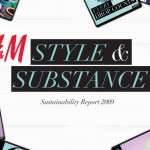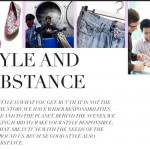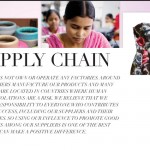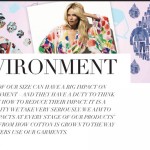H&M-gruppen (som även äger COS, Monki, Weekday, Cheap Monday och H&M Home) publicerade igår sin årliga sustainability report, ett 87-sidigt dokument som finns att ladda ner här för den som är intresserad.
H&M har gjort mycket för att förbättra hur de arbetar ur miljösynpunkt, de säljer till exempel en hel del ekologiska bomullsplagg och kom tidigare i år ut med en Garden Collection, gjord av återvunnet och ekologiskt material. Men, de har även fått mycket kritik under året som gått. Det uppdagades ju till exempel att en del av dessa ekologiska bomullsplagg inte alls var gjorda av ekologisk bomull. H&M skyllde på tillverkarna och lovade att förbättra kontrolleringen. I New York fick de även kritik för att förstöra kläder som av en eller annan anledning inte kunde säljas istället för att skänka dem till välgörenhetsorganisationer. Detta var under den kallaste vintertiden och deras enorma soppåsar var fyllda av sönderklippta dunjackor och andra varma kläder — medan fattiga och hemlösa frös på gatorna. En missad chans för H&M att visa framfötterna som ett socialt engagerat företag.
I denna rapport hävdar H&M att de från 2004 till 2009 minskade företagets “carbon footprint” (koldioxidutsläpp) med 32%, och därmed översteg målet som var 10%. Det man hoppas att vi inte ska förstå är att detta är i relation till försäljningen, vilket betyder att de kanske inte alls minskade sitt koldioxidutsläpp, så länge försäljningssiffrorna gick upp tillräckligt mycket. Om man gräver lite djupare hittar man de sanna siffrorna — H&M gruppens koldioxidutsläpp ökade med 29% från 2004 till 2009. Anledningen till att man kan säga att man minskade sitt carbon footprint med 32% är att försäljningen ökade med hela 88%. Det nya målet för 2010-12 är en minskning på ynka 5%, i relation till försäljningen så klart.
H&M engagerar sig i många bra initiativ också, bland annat samhällsprojekt i samarbete med organisationer som UNICEF, Rädda Barnen, WaterAid och Designers Against AIDS. De arbetar också aktivt med sina fabriker i utvecklingsländer och har tagit fram en Code of Conduct för att se till att inga brott mot människorättigheter förekommer (men eftersom H&M inte äger sina fabriker betalas bara absolut minimilön till arbetare) samt kräver att alla anställda genomgår sustainability training.
Som en av de största modekoncernerna i Sverige (och världen) har vi dock rätt att förvänta oss mer av H&M-gruppen. VD Karl-Johan Persson skriver i inledningen till rapporten att “H&M strävar efter att vara ett hållbart företag – ekonomiskt, samhälleligt och miljömässigt [ett välkänt begrepp som kallas Triple Bottom Line]. Om vi ska fortsätta vara ett framgångsrikt företag, tror vi att det är absolut nödvändigt att integrera hållbarhetstänkande i allt vi gör.”
Vi kan ju bara hoppas att H&M verkligen börjar leva upp till dessa förväntningar.
The H&M Group (that also owns COS, Monki, Weekday, Cheap Monday and H&M Home) published their annual sustainability report yesterday, a 87-page document available for download here for those who are interested.
H&M has done a lot to improve their environmental policies, such as increasing the number of garments made with organic cotton, and earlier this year coming out with a Garden Collection, made from recycled and organic materials. But, they have also received quite a bit of criticism during the past year. For example, it was revealed that some of these organic cotton garments were, in fact, not made from organic cotton. H&M blamed the manufacturers and promised to increase oversight. In New York, they also came under fire for destroying clothing that for one reason or another was unsellable instead of donating it to charity. This was during the coldest time of winter and these huge garbage bags were filled with cut-up down jackets and other warm garments — while poor and homeless people were freezing in the streets. A missed opportunity for H&M to establish themselves as a socially responsible business.
In this report, H&M also claims to have exceeded their carbon footprint reduction goals in the 2004-2009 time period. Instead of the 10% goal, they state that the total reduction was an impressive 32%. What they are hoping we don’t understand is that this figure is in relation to sales volume, which means that the company may not at all have reduced their emissions if sales increased enough. Digging a bit deeper, I find the true numbers — the H&M Group’s total carbon footprint actually increased by 29% from 2004-2009. The reason the company can claim the 32% reduction is because their sales increased by a whopping 88%. The new goal for 2010-12 is a carbon footprint reduction of merely 5%, in relation to sales volume of course.
H&M is engaged in many good initiatives as well, funding projects in collaboration with organizations like UNICEF, Save the Children, WaterAid and Designers Against AIDS. They also work actively with their factories in the developing world and have developed a Code of Conduct to make sure that no crimes against human rights are committed (but since H&M does not own their factories, the workers are paid absolute minimum salaries) and they also require all employees to complete sustainability training.
As one of the largest fashion groups in Sweden (and the world) we do have a right to expect more from the H&M Group. CEO Karl-Johan Persson writes in the introduction to the report that “H&M strives to be a sustainable business — financially, socially and environmentally [a concept known as the Triple Bottom Line]. If we are to continue being a successful company, we believe that integrating sustainable thinking into everything we do is absolutely necessary.”
We can only hope that H&M truly starts living up to those expectations.













